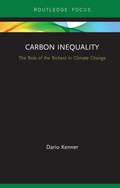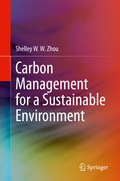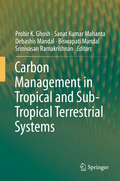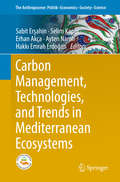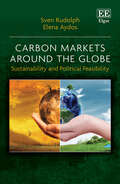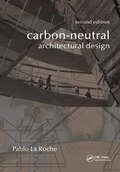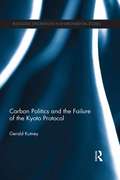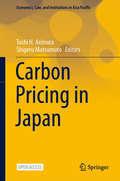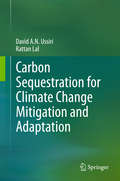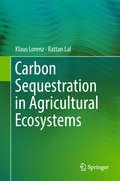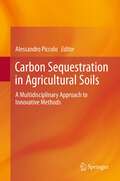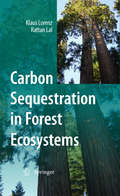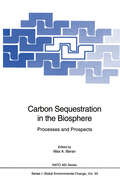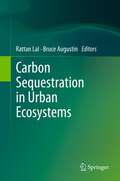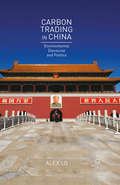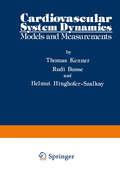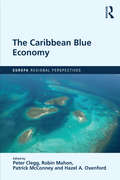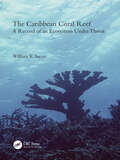- Table View
- List View
Carbon Inequality: The Role of the Richest in Climate Change (Routledge Focus on Environment and Sustainability)
by Dario KennerWith a specific focus on the United States and the United Kingdom, Carbon Inequality studies the role of the richest people in contributing to climate change via their luxury consumption and their investments. In an innovative contribution, it attempts to quantify personal responsibility for shareholdings in large fossil fuel companies. This book explores the implications of the richest people’s historic responsibility for global warming, the impacts of which affect them less than most others in global society. Kenner analyses how the richest people running large oil and gas companies have successfully used their political influence to lobby the US and UK government. This assessment of their growing political power is particularly pertinent at a time of increasing inequality and growing public awareness of the impact of climate change. The book also highlights the crucial role of the richest in blocking the low-carbon transition in the US and the UK, exploring how this could be countered to ensure fossil fuels are fully replaced by renewable energy. This book will be of great relevance to scholars and policy makers with an interest in inequality, climate change and sustainability transitions.
Carbon Inequality: The Role of the Richest in Climate Change (Routledge Focus on Environment and Sustainability)
by Dario KennerWith a specific focus on the United States and the United Kingdom, Carbon Inequality studies the role of the richest people in contributing to climate change via their luxury consumption and their investments. In an innovative contribution, it attempts to quantify personal responsibility for shareholdings in large fossil fuel companies. This book explores the implications of the richest people’s historic responsibility for global warming, the impacts of which affect them less than most others in global society. Kenner analyses how the richest people running large oil and gas companies have successfully used their political influence to lobby the US and UK government. This assessment of their growing political power is particularly pertinent at a time of increasing inequality and growing public awareness of the impact of climate change. The book also highlights the crucial role of the richest in blocking the low-carbon transition in the US and the UK, exploring how this could be countered to ensure fossil fuels are fully replaced by renewable energy. This book will be of great relevance to scholars and policy makers with an interest in inequality, climate change and sustainability transitions.
Carbon Management for a Sustainable Environment
by Shelley W. ZhouThis textbook presents students with a systematic approach for the quantification and management of greenhouse gas emissions (GHG) and provides best practices for optimal carbon management and quantification. The book begins with an overview of climate change basics and goes on to discuss carbon footprint measurements, carbon management concepts, and concludes by presenting carbon reduction solutions with applications for green buildings, smart transportation, waste management, and carbon trading and offsetting. The author provides practical examples and carbon management models that support innovative reduction solutions and presents a roadmap for the implementation and development of carbon management strategies, making it a useful resource for both upper undergraduate and graduate students as well as practitioners seeking a comprehensive framework to conduct carbon management.
Carbon Management in Tropical and Sub-Tropical Terrestrial Systems
by Probir K. Ghosh Sanat Kumar Mahanta Debashis Mandal Biswapati Mandal Srinivasan RamakrishnanSoil organic carbon (SOC), a key component of the global carbon (C) pool, plays an important role in C cycling, regulating climate, water supplies and biodiversity, and therefore in providing the ecosystem services that are essential to human well-being. Most agricultural soils in temperate regions have now lost as much as 60% of their SOC, and as much as 75% in tropical regions, due to conversion from natural ecosystems to agricultural uses and mainly due to continuous soil degradation. Sequestering C can help to offset C emissions from fossil fuel combustion and other C-emitting activities, while also enhancing soil quality and long-term agronomic productivity. However, developing effective policies for creating terrestrial C sinks is a serious challenge in tropical and subtropical soils, due to the high average annual temperatures in these regions. It can be accomplished by implementing improved land management practices that add substantial amounts of biomass to soil, cause minimal soil disturbance, conserve soil and water, improve soil structure, and enhance soil fauna activity. Continuous no-till crop production is arguably the best example. These soils need technically sound and economically feasible strategies to sustainably enhance their SOC pools. Hence, this book provides comprehensive information on SOC and its management in different land-use systems, with a focus on preserving soils and their ecosystem services. The only book of its kind, it offers a valuable asset for students, researchers, policymakers and other stakeholders involved in the sustainable development and management of natural resources at the global level.
Carbon Management, Technologies, and Trends in Mediterranean Ecosystems (The Anthropocene: Politik—Economics—Society—Science #15)
by Sabit Erşahin Selim Kapur Erhan Akça Ayten Namlı Hakkı Emrah ErdoğanThis book pursues a unique approach, investigating both the ecological and socio-economic aspects of carbon management in Mediterranean ecosystems. All chapters are based on papers originally presented at the 1st Istanbul Carbon Summit, held at Istanbul Technical University, 2–4 April, 2014, and revised following a peer-review process.The book addresses the summit’s three main themes – carbon management, carbon technologies, and carbon trends – while also offering chapters on the economic aspects of carbon management and the ecological aspects of the carbon cycle. The chapters on economic aspects analyze the carbon trade and its institutional, political, and legislative structures in different Mediterranean nations, while those on ecological aspects review the discourse on and analysis of the related ecological factors and their feedback due to governance processes.
Carbon Markets Around the Globe: Sustainability and Political Feasibility
by Sven Rudolph Elena AydosIn this timely book, Sven Rudolph and Elena Aydos take an interdisciplinary approach that combines sustainability economics, political economy and legal concepts to answer two fundamental questions: How can carbon markets be designed to be effective, efficient and just at the same time? And how can the political barriers to sustainable carbon markets be overcome?The first part of the book develops an innovative and robust Sustainable Model Rule for evaluating carbon market design, which is demonstrated in practice through chapters assessing the vast majority of real-life emissions trading schemes (ETS) from around the world. In the second part, the focus shifts to political feasibility, providing a political economy framework for evaluating ETS. The authors examine empirical data from case studies in several countries, and identify strategies and policy windows for implementing truly sustainable ETS.The cutting-edge tools outlined in this book for conducting assessments of carbon market design and feasibility will be invaluable for climate policy practitioners and environmental lawyers at national and international levels. The book will also be an important resource for policy makers, think tanks and stakeholders, as well as for scholars and students in environmental economics and climate change law and policy.
Carbon-Neutral Architectural Design
by Pablo M. La RocheThe energy used to operate buildings is one of the most significant sources of greenhouse gas emissions. While it is possible to reduce emissions through climate-responsive design, many architects are not trained to do this. Filling an urgent need for a design reference in this emerging field, this book describes how to reduce building-related greenhouse gas emissions through appropriate design techniques. It presents strategies to achieve CO2 reductions, with an emphasis on control of energy flows through the building envelope and passive heating and cooling strategies. This new, revised edition is updated throughout, and includes a new chapter on building simulations.
Carbon-Neutral Architectural Design
by Pablo M. La RocheThe energy used to operate buildings is one of the most significant sources of greenhouse gas emissions. While it is possible to reduce emissions through climate-responsive design, many architects are not trained to do this. Filling an urgent need for a design reference in this emerging field, this book describes how to reduce building-related greenhouse gas emissions through appropriate design techniques. It presents strategies to achieve CO2 reductions, with an emphasis on control of energy flows through the building envelope and passive heating and cooling strategies. This new, revised edition is updated throughout, and includes a new chapter on building simulations.
Carbon Politics and the Failure of the Kyoto Protocol: Carbon Politics And The Failure Of The Kyoto Protocol (Routledge Explorations in Environmental Studies)
by Gerald KutneyCarbon Politics and the Failure of Kyoto charts the framework and political evolution of the Kyoto Protocol negotiations and examines the ensuing failure of the international community to adequately address climate change. The focus is not on the science or consequences of climate change but on the political gamesmanship of the major players throughout the UNFCCC negotiation process. More than an updated history of the subject matter, this book provides a detailed study of the carbon targets which became the biggest influencing factor on the reaction of nations to Kyoto’s binding agreements. The book provides an in-depth analysis of the leading nations’ motives, including the US, China and Germany, in entering the negotiations, in particular, their economic interests. Despite the effort to combat climate change in politics that the negotiations represent, the book concludes that an agreement which requires almost 200 very different nations to agree on a single protocol is doomed to failure. The book offers a novel contribution to our understanding of this failure and suggests alternative frameworks and policies to tackle what is arguably the most complex political issue of our time.
Carbon Politics and the Failure of the Kyoto Protocol (Routledge Explorations in Environmental Studies)
by Gerald KutneyCarbon Politics and the Failure of Kyoto charts the framework and political evolution of the Kyoto Protocol negotiations and examines the ensuing failure of the international community to adequately address climate change. The focus is not on the science or consequences of climate change but on the political gamesmanship of the major players throughout the UNFCCC negotiation process. More than an updated history of the subject matter, this book provides a detailed study of the carbon targets which became the biggest influencing factor on the reaction of nations to Kyoto’s binding agreements. The book provides an in-depth analysis of the leading nations’ motives, including the US, China and Germany, in entering the negotiations, in particular, their economic interests. Despite the effort to combat climate change in politics that the negotiations represent, the book concludes that an agreement which requires almost 200 very different nations to agree on a single protocol is doomed to failure. The book offers a novel contribution to our understanding of this failure and suggests alternative frameworks and policies to tackle what is arguably the most complex political issue of our time.
Carbon Pricing in Japan (Economics, Law, and Institutions in Asia Pacific)
by Toshi H. Arimura Shigeru MatsumotoThis open access book evaluates, from an economic perspective, various measures introduced in Japan to prevent climate change. Although various countries have implemented such policies in response to the pressing issue of climate change, the effectiveness of those programs has not been sufficiently compared. In particular, policy evaluations in the Asian region are far behind those in North America and Europe due to data limitations and political reasons.The first part of the book summarizes measures in different sectors in Japan to prevent climate change, such as emissions trading and carbon tax, and assesses their impact. The second part shows how those policies have changed the behavior of firms and households. In addition, it presents macro-economic simulations that consider the potential of renewable energy. Lastly, based on these comprehensive assessments, it compares the effectiveness of measures to prevent climate change in Japan and Western countries.Providing valuable insights, this book will appeal to both academic researchers and policymakers seeking cost-effective measures against climate change.
Carbon Sequestration for Climate Change Mitigation and Adaptation
by David A. Ussiri Rattan LalThis book provides an understanding of the role of human activities in accelerating change in global carbon cycling summarizes current knowledge of the contemporary carbon budget. Starting from the geological history, this volume follows a multidisciplinary approach to analyze the role of human activities in perturbing carbon cycling by quantifying changes in different reservoirs and fluxes of carbon with emphasis on the anthropogenic activities, especially after the industrial revolution. It covers the role of different mitigation options – natural ecological, engineered, and geoengineered processes as well as the emerging field of climate engineering in avoiding dangerous abrupt climate change. Although the targeted audience is the educators, students, researchers and scientific community, the simplified analysis and synthesis of current and up to date scientific literature makes the volume easier to understand and a tool policy makers can use to make an informed policy decisions.
Carbon Sequestration in Agricultural Ecosystems
by Klaus Lorenz Rattan LalA comprehensive book on basic processes of soil C dynamics and the underlying factors and causes which determine the technical and economic potential of soil C sequestration. The book provides information on the dynamics of both inorganic (lithogenic and pedogenic carbonates) and organic C (labile, intermediate and passive). It describes different types of agroecosystems, and lists questions at the end of each chapter to stimulate thinking and promote academic dialogue. Each chapter has a bibliography containing up-to-date references on the current research, and provides the state-of-the-knowledge while also identifying the knowledge gaps for future research. The critical need for restoring C stocks in world soils is discussed in terms of provisioning of essential ecosystem services (food security, carbon sequestration, water quality and renewability, and biodiversity). It is of interest to students, scientists, and policy makers.
Carbon Sequestration in Agricultural Soils: A Multidisciplinary Approach to Innovative Methods
by Alessandro PiccoloThis compilation of techniques, methodologies and scientific data arises from a four-year Italian research project, which took place at university research stations in Turin, Piacenza, Naples and Potenza. Soil Organic Matter (SOM) represents an active and essential pool of the total organic carbon on the planet. Consequently, even small changes in this SOM carbon pool may have a significant impact on the concentration of atmospheric CO2. Recent new understanding of the chemical nature of SOM indicates that innovative and sustainable technologies may be applied to sequester carbon in agricultural soils. Overall results of the project have been applied to develop an innovative model for the prediction and description, both quantitatively and qualitatively, of carbon sequestration in agricultural soils. This book provides experts in different areas of soil science with a complete picture of the effects of new soil management methods and their potentials for practical application in farm management.
Carbon Sequestration in Forest Ecosystems
by Klaus Lorenz Rattan LalCarbon Sequestration in Forest Ecosystems is a comprehensive book describing the basic processes of carbon dynamics in forest ecosystems, their contribution to carbon sequestration and implications for mitigating abrupt climate change. This book provides the information on processes, factors and causes influencing carbon sequestration in forest ecosystems. Drawing upon most up-to-date references, this book summarizes the current understanding of carbon sequestration processes in forest ecosystems while identifying knowledge gaps for future research, Thus, this book is a valuable knowledge source for students, scientists, forest managers and policy makers.
Carbon Sequestration in the Biosphere: Processes and Prospects (Nato ASI Subseries I: #33)
by Max A. BeranAnthropogenic release of carbon dioxide into the atmosphere has been recognized as the primary agent in global climate change. The volume discusses the possibilities for limiting that increase by the long-term storage of carbon in soils, vegetation, wetlands and oceans. Each of these storage media is analysed in detail to elucidate those processes responsible for the uptake and release of carbon. Several chapters address the practical prospects for deliberate interventions aimed at adjusting the balance in favour of uptake over release, i.e. sequestration, while having regard to simultaneous changes in the various environments.
Carbon Sequestration in Urban Ecosystems
by Rattan Lal and Bruce AugustinUrbanization drastically alters the ecosystems structure and functions, disrupts cycling of C and other elements along with water. It alters the energy balance and influences climate at local, regional and global scales. In 2008, urban population exceeded the rural population. In 2050, 70% of the world population will live in urban centers. The number of megacities (10 million inhabitants) increased from three in 1975 to 19 in 2007, and is projected to be 27 in 2025. Rapid urbanization is altering the ecosystem C budget. Yet, urban ecosystems have a large C sink capacity in soils and biota. Judicious planning and effective management can enhance C pool in urban ecosystems, and off-set some of the anthropogenic emissions. Principal components with regards to C sequestration include home lawns and turfs, urban forests, green roofs, park and recreational/sports facilities and urban agriculture.
Carbon Trading in China: Environmental Discourse and Politics
by Alex LoThis book explores the political aspects of China's climate change policy, focusing on the newly established carbon markets and carbon trading schemes. Lo makes a case for understanding the policy change in terms of discourse and in relation to narratives of national power and development.
The Caribbean Blue Economy (Europa Regional Perspectives)
by Peter Clegg Patrick McConney Hazel A. Oxenford Robin MahonThe Blue Economy is emerging on the global scene as a powerful and persuasive new concept for sustainable development based on economic activities associated with the ocean. Several regions globally have adopted this concept at national and regional levels, including the Caribbean. Given the complex, multisectoral and multilevel nature of the Blue Economy, it is clear that different approaches will be needed for different regions. Hence, this volume explores the opportunities, threats and risks involved in operationalising the Blue Economy in the Wider Caribbean Region, defined as northern Brazil to the USA and all mainland and island countries and territories in-between. The first part of the book looks at where the region stands in the global picture regarding adoption of the Blue Economy and what is planned. The second set of chapters examines key crosscutting issues such as ecosystem services, climate change and governance at national and regional levels that could make or break the Blue Economy initiative. The book then goes on to explore the main sectoral activities that will constitute the Blue Economies in the region: fisheries, tourism, shipping and transport, renewable energy, oil and gas, seabed mining and waste management are all considered. The book ends with a synthesis of the political and technical requirements to overcome threats and take advantage of opportunities in the Blue Economy.
The Caribbean Blue Economy (Europa Regional Perspectives)
by Peter Clegg, Robin Mahon, Patrick McConney and Hazel A. OxenfordThe Blue Economy is emerging on the global scene as a powerful and persuasive new concept for sustainable development based on economic activities associated with the ocean. Several regions globally have adopted this concept at national and regional levels, including the Caribbean. Given the complex, multisectoral and multilevel nature of the Blue Economy, it is clear that different approaches will be needed for different regions. Hence, this volume explores the opportunities, threats and risks involved in operationalising the Blue Economy in the Wider Caribbean Region, defined as northern Brazil to the USA and all mainland and island countries and territories in-between. The first part of the book looks at where the region stands in the global picture regarding adoption of the Blue Economy and what is planned. The second set of chapters examines key crosscutting issues such as ecosystem services, climate change and governance at national and regional levels that could make or break the Blue Economy initiative. The book then goes on to explore the main sectoral activities that will constitute the Blue Economies in the region: fisheries, tourism, shipping and transport, renewable energy, oil and gas, seabed mining and waste management are all considered. The book ends with a synthesis of the political and technical requirements to overcome threats and take advantage of opportunities in the Blue Economy.
The Caribbean Coral Reef: A Record of an Ecosystem Under Threat
by William K. SaccoThis book is a visual tour of Caribbean coral reefs between 1968 and 1978. They are the world’s second largest coral reef community and the most threatened. The Caribbean Coral Reef: A Record of an Ecosystem Under Threat offers a priceless historical record made by a photographer who set out to document the major reef species when those reefs were at their prime. Today, coral reefs are under threat as never before and, sadly, most of what is shown in the book's photographs is now gone forever. It is only by comparing the images in this book with what we see now that we are able to fully recognize what we have lost. With its stunning photography and precise, accurate scientific information, this book offers students of coral reefs a wealth of information about this rich, fragile ecosystem. It is also written accessibly for non-academic visitors to the Caribbean reef or anyone interested in the earth’s creatures. Many of the invertebrates will be unfamiliar to most people, and the author reveals fascinating insights into these otherworldly creatures and their lifestyles. Enjoy this field guide to the reefs that were, and savor the beauty of this vanishing environment and its organisms.
The Caribbean Coral Reef: A Record of an Ecosystem Under Threat
by William K. SaccoThis book is a visual tour of Caribbean coral reefs between 1968 and 1978. They are the world’s second largest coral reef community and the most threatened. The Caribbean Coral Reef: A Record of an Ecosystem Under Threat offers a priceless historical record made by a photographer who set out to document the major reef species when those reefs were at their prime. Today, coral reefs are under threat as never before and, sadly, most of what is shown in the book's photographs is now gone forever. It is only by comparing the images in this book with what we see now that we are able to fully recognize what we have lost. With its stunning photography and precise, accurate scientific information, this book offers students of coral reefs a wealth of information about this rich, fragile ecosystem. It is also written accessibly for non-academic visitors to the Caribbean reef or anyone interested in the earth’s creatures. Many of the invertebrates will be unfamiliar to most people, and the author reveals fascinating insights into these otherworldly creatures and their lifestyles. Enjoy this field guide to the reefs that were, and savor the beauty of this vanishing environment and its organisms.
Caribbee: Thomas Kydd 14 (Thomas Kydd #14)
by Julian Stockwin'In Stockwin's hands the sea story will continue to entrance readers across the world' - GuardianMore than a decade ago, Thomas Kydd and Nicholas Renzi were in the Caribbean as sailors before the mast in the old Trajan. Now Kydd, a storied hero of Trafalgar, holds the glory of being post-captain of the 32-gun frigate, L'Aurore. After unremitting war a Caribbean posting seems a welcome respite. But Kydd and Renzi soon find themselves facing a familiar threat as the French imperil Britain's vital sugar trade.When merchantmen begin vanishing from the sea, Kydd and Renzi must embark on a dangerous game of espionage, seamanship and breath-taking action in order to destroy a new and terrible danger to the Empire.*********************What readers are saying about CARIBBEE'A proper swashbuckling affair' - 5 stars'Totally amazing!' - 5 stars'Loved this book' - 5 stars'A real find' - 5 stars'A gripping read' - 5 stars
Caring For Habitats: Caring For Habitats (library Ebook (Environment Detective Investigates #2)
by Jen GreenWhat is a habitat?Why are habitats under threat?How can we help to take care of habitats?The Environment Detective Investigates helps you to answer these questions and many more about habitats. Find out about the different habitats on Earth, what harm pollution is doing to habitats and why they need our protection.
